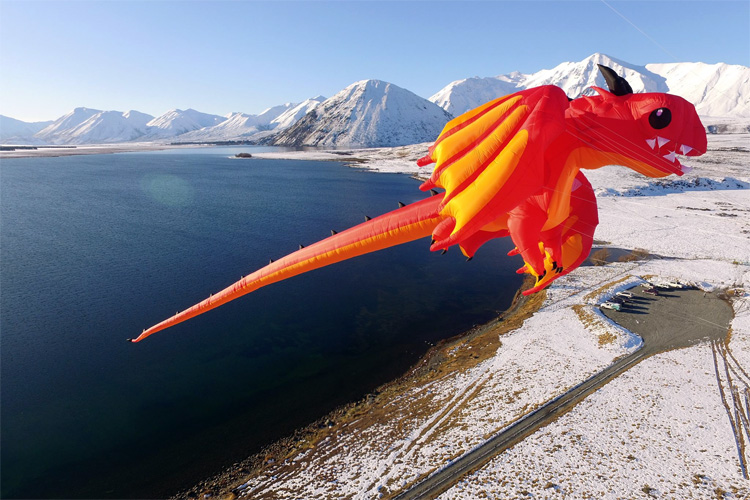Before Dominic Jalbert's 1950s development of "soft" kites, which use the stagnation pressure of airflow (Bernoulli's principle) as a structural element, large kites were size-limited by frame strength.
The largest Japanese Wan Wans could be more than 20 meters in diameter (315 m2) but weighed an impractical two tonnes or more.
The Holland Kite Team, led by Gerard van der Loo, made the first successful very large soft kite - the CS550 (550 m2, <150 kgs), in 1982.
Their guiding principle, which has been adopted for all the large kites that Peter Lynn Kites have made, is that they should have as little pull as possible.
In 1983, Edmonds Community College in Washington State, USA, made a more conventional parafoil style kite that was larger than the Dutch kite.
But its launch director, Steve Edeiken, fell and died when he became entangled in the bridles while launching it.
By the American Kite Association's criteria at that time - flying at an altitude greater than the kite's width for more than two minutes - this flight qualified for the record.
Still, it was never recognized due, I expect, to the tragic consequences.
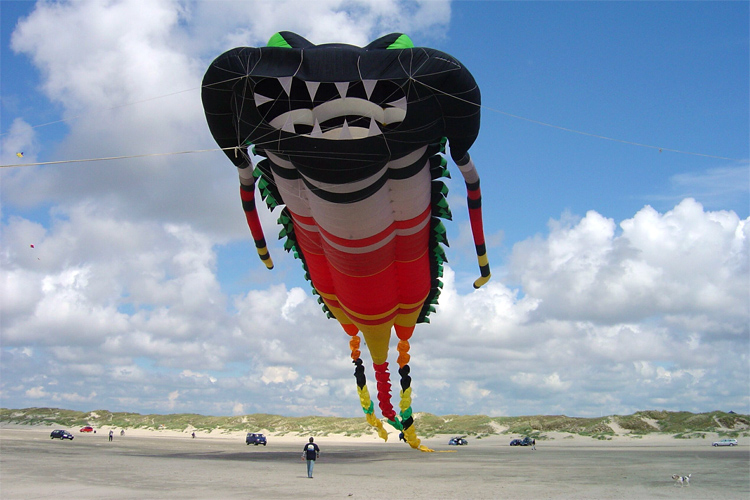
The Holland Kite Team flew their large kite for the last time at the 1995 Napier Kite Festival in New Zealand, preparing the way for the Megabite, Peter Lynn Kites' first very large kite, built that year.
It flew at many events and officially received the Guinness World Record during the Bristol International Kite Festival in 1997 by operating without any part touching the ground for more than 20 minutes.
The size of large kites cannot be simply defined, and the areas I quote are usually more conservative than Guinness (and media) often claim.
In our view, the "qualifying area" is the projected area of the kite when inflated, not the stretched-out dimensions, and does not include tails and non-lifting appendages.
Guinness declared the Megabite to be 933 m2, but by our criteria, it's 635 m2., as is the Mega Ray built in 1997, which we made as near to the same area as possible so that both could be claimed by events as the "World's Largest Kite."
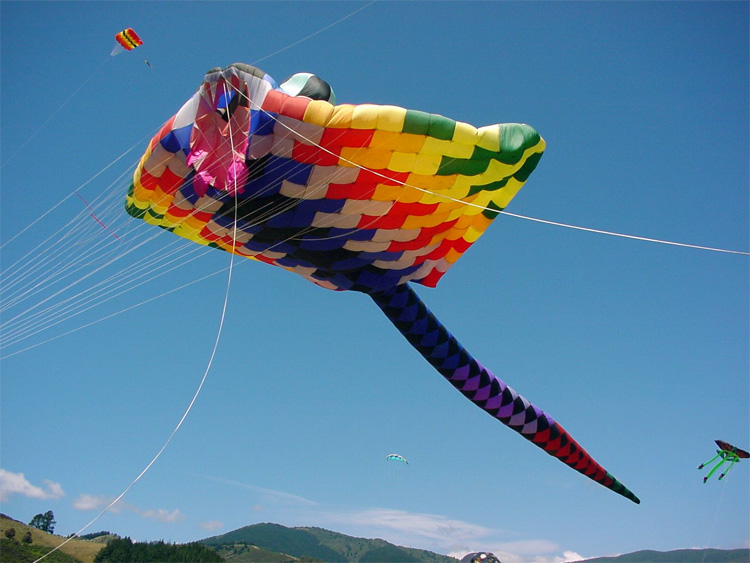
The Megabite was subsequently purchased by Gerard van der Loo/Vliegerop and has now passed to Dominique Scholtes, who occasionally flies it at events.
The Mega Ray was also flown at many events by Peter Lynn Kites and then sold to Lutz Treczoks in Germany.
Since Lutz's untimely death (not from a kite accident), the Mega Ray has been ably flown by Sebastian Ju and team, also from Germany.
The Megabite and Mega Ray are made from zipping together sections to enable travel by air as personal luggage.
Zips work well enough but can fail when subjected to scraping as the kites launch and land.
All our subsequent very large kites have been of one-piece construction and are freighted to events.
The first was a 950 m2, inflated Kuwait flag kite for the Al Farsi Kite Team, recognized as the new world's largest kite by Guinness on February 15, 2005.
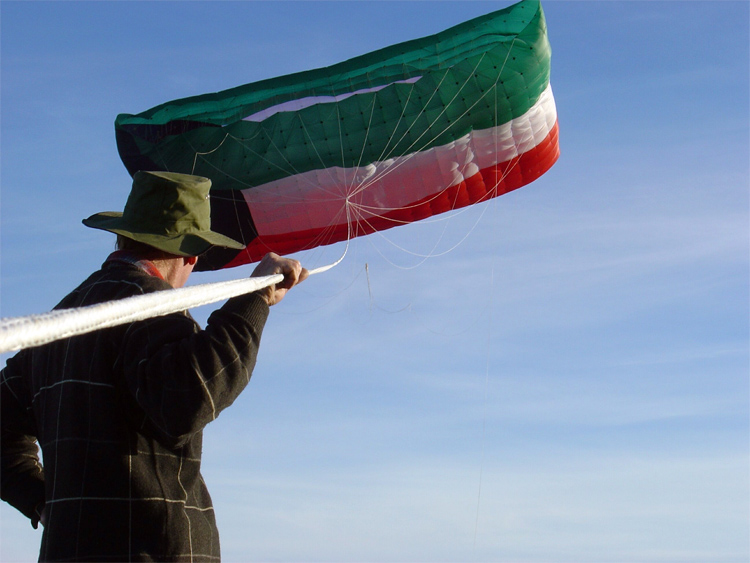
Also, in that year, flag kites of this size were made for Masaaki Modegi in Japan - the Mega Moon - and for David Gomberg in the United States - a US flag.
For emergency take-down, our very large kites use various systems.
The Megabite and Mega Ray both have velcroed sections on their upper surfaces that can be ripped open to deflate the kite by pulling a cord paralleling the main line.
Flag-style kites use a different system.
When the main line is released, a line attached to the kite's trailing edge causes the kite to turn over, deflate rapidly, and descend.
In 2011, Peter Lynn Kites made a 1,250 m2 inflated kite for the Al Farsis. It's a large Ray called The Pearl.
As for the Mega Ray, a line attached to the nose is used to depower the kite and cause it to drift back to the ground without deflating.
But the Mega Ray also has a rip panel.
Because of Al Farsi's nervousness about the nose line as the only take-down option, The Pearl has only ever been flown three times and has just arrived back in New Zealand to have a rip panel fitted (if biosecurity authorities ever release it!).
In 2018, a new 1,250 m2, inflated flag-style kite was built for the Al Farsi.
Called The Hope, it's just had a second successful outing at Berck-sur-Mer in France.
It is the first very large single-line soft kite that can fly without stabilizing sidelines, though the Mega Ray and The Pearl can nearly do it in light, smooth winds.
Critics have questioned whether huge kites are really "kites" at all, seeing as until now, they have required active stabilizing by teams of people on the sidelines.
I tend to agree with them while recognizing that kite events are more interested in attracting media attention than in such nuances.
Sidelines enable very large kites to fly in a limited space and eliminate the requirement for self-stability, which has made making large kites much easier, given that there is no theory of stability by which such kites can be designed. Nor is it possible to scale from smaller versions.
This is because three factors affecting stability, aerodynamic forces, weight, and mass, don't stay in proportion as size increases - weight and mass are not directly related for soft kites because the enclosed air has mass but no weight).
Aerodynamic forces increase with the square of dimension, as weight nearly does in the size range of larger kites, but mass increases as the cube of dimension.
This matters because when a kite recovers from leaning over, the rate of recovery is slowed by the kite's mass, with an undeterminable effect on its stability.
The Pearl is six times the span and length of a standard Maxi Ray, about ten times as heavy, and has 36 times the area but encloses 216 times the air mass (9,504 kg versus 44 kg).
As for smaller kites, therefore, the only available design process, except for informed guesses, is trial and error, which is impractical for kites that each take many months to construct, 20 plus tonne anchors, a team of fliers, and substantial organization for every flight.
To reduce the effect of enclosed mass on the stability of very large kites, we use the super ripstop construction system.
Earlier large kites like the Dutch CS550 and the Edmonds College parafoil connected their top and bottom skins with multiple ribs in conventional parafoil-style type construction.
In consequence, the air in each cell must move with the kite during any correction.
With super ripstop construction, the top and bottom skins are connected by multiple cords, which allow the kite to rotate independently of the enclosed air.
I doubt that very large soft kites can be single-line stable without this facility, though I'm unsure about the size of any given style at which this mass effect becomes critical.
But from 20 years of watching various large soft kites flying with sidelines, it seemed every chance a very large flag-style kite with a suitable tail could fly stable on a single line.
Fortunately, I now have a "theory of tails," which is verging on the quantitative.
Not having any enclosed air mass, flat tails do scale predictably enough, so we were able to test variations on smaller flag kites before committing to a full-size version.
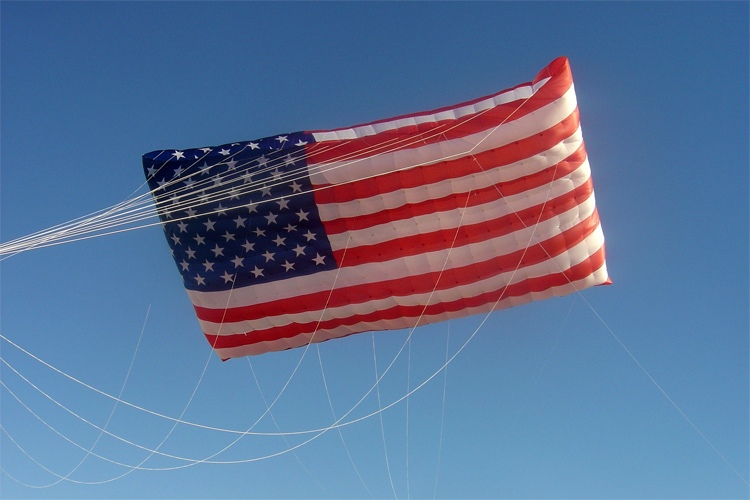
And it worked! A success that I'm pleased to claim a share of, even though it seemed too easy. A small offset for the huge string of kite failures that I can also lay claim to!
The wind was very light at Berck, so we don't yet know what The Hope's upper wind limit will be for single-line flying, but we expect it to be useful.
It was unstable during its first flight there, climbing immediately to full height, only to dive back down, climb again, and so on.
For this, we can blame Swiss mathematician and physicist Daniel Bernoulli (1700-1782), whose equation describing fluid flow establishes that when velocity increases, pressure decreases.
This is experienced as the bath plug pulling in when you try to hold it partly out.
During The Hope's first flight at Berck, there was a significant wind gradient - almost no wind at ground level, but 15km/h or more at 100 meters up.
When it reached maximum altitude, there was significantly more wind above the kite than under it.
There was, therefore, a net low-pressure area above the rear of the kite, which caused it to nose down and descend - it's called a luff.
This was also the cause of the infamous restaurant trash by Mega Ray in Sardinia (2001?).
Very large soft kites are susceptible to this because they are carefully tuned - by adjusting camber - for minimum pull, so they fly on the verge of bluffing, and also because they are generally flown very close to the ground.
When there is a significant wind gradient, they should, therefore, be flown higher, or pilot kites should be used to hold the leading edge up.
As some of this is from recollection, I'll be pleased to correct any errors brought to my attention.
Words by Peter Lynn | Founder of Peter Lynn Kites
